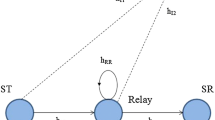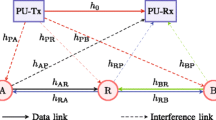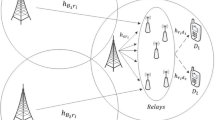Abstract
In this paper, we investigate the energy efficiency maximization (EEM) problem for underlay cognitive multiuser two-way relay networks, by jointly optimizing the power allocation of secondary users and the beamforming matrix of the cognitive relay. The EEM problem is highly non-convex and thus the global optimum is intractable. We first show that the EEM problem can be equivalently transformed to a difference of convex program. Then an efficient iterative algorithm based on the constrained concave convex procedure is proposed to obtain a local optimum of the EEM problem. Simulation results are presented to demonstrate that our proposed solution performs much better than existing schemes even when the iterative number is very small.



Similar content being viewed by others
Notes
We adopt the assumption that the interference from the PU to SU is neglected as [5–7]. In IEEE 802:22 standard, the secondary wireless regional area network (WRAN) is located far away from the primary transmitter and hence the interference from the primary transmitter can be neglected at the secondary receiver.
An optimization problem called DC program if its objective and/or constraints can be written as DC functions [20].
References
Jitvanichphaibool, K., Liang, Y. C., & Zhang R. (2009). Beamforming and power control for multi-antenna cognitive two-way relaying. In Proceedings of IEEE WCNC (April 5–8, pp. 1–6). Hungary: Budapest.
Li, Q., Ting, S. H., Pandharipande, A., & Han, Y. (2011). Cognitive spectrum sharing with two-way relaying systems. IEEE Transactions on Vehicular Technology, 60(3), 1233–1240.
Ubaidulla, P., & Aïssa, S. (2012). Optimal relay selection and power allocation for cognitive two-way relaying networks. IEEE on Wireless Communications Letters, 1(3), 225–228.
Safavi, S. H., Ardebilipour, M., & Salari, S. (2012). Relay beamforming in cognitive two-way networks with imperfect channel state information. IEEE on Wireless Communications Letters, 1(4), 344–347.
Jiang, D., Zhang, H., Yuan, D., & Bai, Z. (2010). Two-way relaying with linear processing and power control for cognitive radio systems. In Proceedings of IEEE on ICCS (pp. 284–288).
Jiang, D., Zhang, H., & Yuan, D. (2011). Multiuser two-way relay processing and power control methods for cognitive radio networks. Wireless Communications and Mobile Computing. doi:10.1002/wcm.1183.
Bournaka, G., Cumanan, K., Lambotharan, S., & Lazarakis, F. (2012). An SINR balancing technique for a cognitive two-way relay network. In Proceedings of IEEE on VTC Fall (pp. 1–5).
Mu, H., & Tugnait, J. K. (2012). MSE-based source and relay precoder design for cognitive radio multiuser two-way relay systems. In Proceedings of IEEE on WCNC (pp. 742–747).
Mu, H., & Tugnait, J. K. (2013). MSE-based source and relay precoder design for cognitive multiuser multi-way relay systems. IEEE Transactions on Signal Processing, 61(7), 1770–1785.
Li, Q., Luo, L., Zhang, G., & Qin, J. (2014). Optimal precoder design for non-regenerative MIMO cognitive two-way relay systems with underlay spectrum sharing. Wireless Personal Communications, 75, 1373–1390.
Miao, G., Himayat, N., & Li, Y. (2010). Energy-efficient link adaptation in frequency-selective channels. IEEE Transactions on Communications, 58(2), 545–554.
Han, C., Harrold, T., Armour, S., Krikidis, I., Videv, S., Grant, P. M., et al. (2011). Green radio: Radio techniques to enable energy-efficient wireless networks. IEEE on Communications Magazine, 49(6), 46–54.
Xu, J., Qiu, L., & Yu, C. (2011). Improving energy efficiency through multimode transmission in the downlink MIMO systems. EURASIP Journal on Wireless Communications and Networking, 2011, 1–12.
Xue, Q., Pantelidou, A., Latva-aho, M., & Aazhang, B. (2011). Optimal relay selection for energy-efficient multicast. Wireless Personal Communications, 59, 433–446.
Xiong, C., Li, Y., Zhang, S., Chen, Y., & Xu, S. (2012). Energy-efficient resource allocation in OFDMA networks. IEEE Transactions on Communications, 60(12), 3767–3788.
Wang, Y., Xu, W., Yang, K., & Lin, J. (2012). Optimal energy-efficient power allocation for OFDM-based cognitive radio networks. IEEE on Communications Letters, 16(9), 1420–1423.
Mao, J., Xie, G., Gao, J., & Liu, L. (2013). Energy efficiency optimization for cognitive radio MIMO broadcast channels. IEEE on Communications Letters, 17(2), 337–340.
Wang, S., Ge, M., & Zhao, W. (2013). Energy-efficient resource allocation for OFDM-based cognitive radio networks. IEEE Transactions on Communications, 61(8), 3181–3191.
Akin, S., & Gursoy, M. C. (2013). On the throughput and energy efficiency of cognitive MIMO transmissions. IEEE Transactions on Vehicular Technology, 62(7), 3245–3260.
Horst, R., & Thoai, N. V. (1999). DC programming: Overview. Journal of Optimization Theory and Applications, 103(1), 1–43.
Smola A. J., Vishwanathan S. V. N., & Hofmann, T. (2005). Kernel methods for missing variables. In Proceedings of 10th International Workshop on Artificial Intelligence and Statistics.
Yuille, A. L., & Rangarajan, A. (2003). The concave-convex procedure. Neural Computation, 15(4), 915–936.
Boyd, S., & Vandenberghe, L. (2004). Convex optimization. Cambridge: Cambridge University Press.
Magnus, J., & Neudecker, H. (2007). Matrix Differential Calculus with Applications in Statistics and Econometrics. Hoboken: Wiley.
Nesterov, Y., & Nemirovskii, A. (1994). Interior point polynomial algorithms in convex programming. Philadelphia: SIAM.
Acknowledgments
This work was supported in part by the National Natural Science Foundation of China under Grants 61472458 and 61173148, in part by the Guangdong Natural Science Foundation under Grants 2014A030311032 and 2014A030310374, and in part by the Fundamental Research Funds for the Central Universities under Grant 15lgpy15.
Author information
Authors and Affiliations
Corresponding author
Rights and permissions
About this article
Cite this article
Li, Q., Liu, F., Zhou, X. et al. Energy Efficiency for Underlay Cognitive Multiuser Two-Way Relay Networks. Wireless Pers Commun 86, 1541–1555 (2016). https://doi.org/10.1007/s11277-015-3005-y
Published:
Issue Date:
DOI: https://doi.org/10.1007/s11277-015-3005-y




